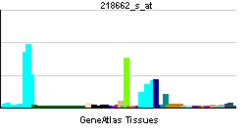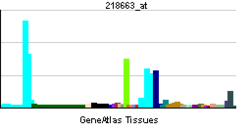- NCAPG
-
Non-SMC condensin I complex, subunit G Identifiers Symbols NCAPG; CAPG; CHCG; FLJ12450; HCAP-G; MGC126525; NY-MEL-3 External IDs OMIM: 606280 HomoloGene: 44071 GeneCards: NCAPG Gene Gene Ontology Molecular function • protein binding Cellular component • condensin complex
• nucleus
• chromosome
• cytoplasmBiological process • cell cycle
• mitosis
• mitotic chromosome condensation
• mitotic chromosome condensation
• cell divisionSources: Amigo / QuickGO RNA expression pattern 

More reference expression data Orthologs Species Human Mouse Entrez 64151 n/a Ensembl ENSG00000109805 n/a UniProt Q9BPX3 n/a RefSeq (mRNA) NM_022346 n/a RefSeq (protein) NP_071741 n/a Location (UCSC) Chr 4:
17.81 – 17.85 Mbn/a PubMed search [1] n/a Condensin complex subunit 3 also known as condensin subunit CAP-G (CAP-G) or non-SMC condensin I complex subunit G (NCAPG) is a protein that in humans is encoded by the NCAPG gene.[1][2][3] CAP-G is a subunit of condensin I, a large protein complex involved in chromosome condensation.
Interactions
NCAPG has been shown to interact with DNMT3B.[4]
References
- ^ Jager D, Stockert E, Jager E, Gure AO, Scanlan MJ, Knuth A, Old LJ, Chen YT (Aug 2000). "Serological cloning of a melanocyte rab guanosine 5'-triphosphate-binding protein and a chromosome condensation protein from a melanoma complementary DNA library". Cancer Res 60 (13): 3584–91. PMID 10910072.
- ^ Kimura K, Cuvier O, Hirano T (Feb 2001). "Chromosome condensation by a human condensin complex in Xenopus egg extracts". J Biol Chem 276 (8): 5417–20. doi:10.1074/jbc.C000873200. PMID 11136719.
- ^ "Entrez Gene: NCAPG non-SMC condensin I complex, subunit G". http://www.ncbi.nlm.nih.gov/sites/entrez?Db=gene&Cmd=ShowDetailView&TermToSearch=64151.
- ^ Geiman TM, Sankpal UT, Robertson AK, Chen Y, Mazumdar M, Heale JT, Schmiesing JA, Kim W, Yokomori K, Zhao Y, Robertson KD (2004). "Isolation and characterization of a novel DNA methyltransferase complex linking DNMT3B with components of the mitotic chromosome condensation machinery". Nucleic Acids Res. 32 (9): 2716–29. doi:10.1093/nar/gkh589. PMC 419596. PMID 15148359. http://www.pubmedcentral.nih.gov/articlerender.fcgi?tool=pmcentrez&artid=419596.
Further reading
- Strausberg RL, Feingold EA, Grouse LH, et al. (2003). "Generation and initial analysis of more than 15,000 full-length human and mouse cDNA sequences.". Proc. Natl. Acad. Sci. U.S.A. 99 (26): 16899–903. doi:10.1073/pnas.242603899. PMC 139241. PMID 12477932. http://www.pubmedcentral.nih.gov/articlerender.fcgi?tool=pmcentrez&artid=139241.
- Ota T, Suzuki Y, Nishikawa T, et al. (2004). "Complete sequencing and characterization of 21,243 full-length human cDNAs.". Nat. Genet. 36 (1): 40–5. doi:10.1038/ng1285. PMID 14702039.
- Geiman TM, Sankpal UT, Robertson AK, et al. (2004). "Isolation and characterization of a novel DNA methyltransferase complex linking DNMT3B with components of the mitotic chromosome condensation machinery.". Nucleic Acids Res. 32 (9): 2716–29. doi:10.1093/nar/gkh589. PMC 419596. PMID 15148359. http://www.pubmedcentral.nih.gov/articlerender.fcgi?tool=pmcentrez&artid=419596.
- Gerhard DS, Wagner L, Feingold EA, et al. (2004). "The status, quality, and expansion of the NIH full-length cDNA project: the Mammalian Gene Collection (MGC).". Genome Res. 14 (10B): 2121–7. doi:10.1101/gr.2596504. PMC 528928. PMID 15489334. http://www.pubmedcentral.nih.gov/articlerender.fcgi?tool=pmcentrez&artid=528928.
- Xing H, Wilkerson DC, Mayhew CN, et al. (2005). "Mechanism of hsp70i gene bookmarking.". Science 307 (5708): 421–3. doi:10.1126/science.1106478. PMID 15662014.
- Nousiainen M, Silljé HH, Sauer G, et al. (2006). "Phosphoproteome analysis of the human mitotic spindle.". Proc. Natl. Acad. Sci. U.S.A. 103 (14): 5391–6. doi:10.1073/pnas.0507066103. PMC 1459365. PMID 16565220. http://www.pubmedcentral.nih.gov/articlerender.fcgi?tool=pmcentrez&artid=1459365.
- Olsen JV, Blagoev B, Gnad F, et al. (2006). "Global, in vivo, and site-specific phosphorylation dynamics in signaling networks.". Cell 127 (3): 635–48. doi:10.1016/j.cell.2006.09.026. PMID 17081983.
- Ewing RM, Chu P, Elisma F, et al. (2007). "Large-scale mapping of human protein-protein interactions by mass spectrometry.". Mol. Syst. Biol. 3 (1): 89. doi:10.1038/msb4100134. PMC 1847948. PMID 17353931. http://www.pubmedcentral.nih.gov/articlerender.fcgi?tool=pmcentrez&artid=1847948.
Structures of the cell nucleus / nuclear protein Envelope (membrane)/
nuclear laminaNucleolus Other Chromatin · Dot (PML body) · Paraspeckle
SMC protein: Cohesin (SMC1A, SMC1B, SMC3) · Condensin (NCAPD2, NCAPD3, NCAPG, NCAPG2, NCAPH, NCAPH2, SMC2, SMC4) · DNA repair (SMC5, SMC6)
Transition nuclear protein: TNP1, TNP2
Nuclear matrix · Nucleoplasm · Nucleoskeleton · Nucleosol
see also transcription factors and intracellular receptorssee also nucleus diseases
B strc: edmb (perx), skel (ctrs), epit, cili, mito, nucl (chro)Categories:- Human proteins
- Chromosome 4 gene stubs
Wikimedia Foundation. 2010.
